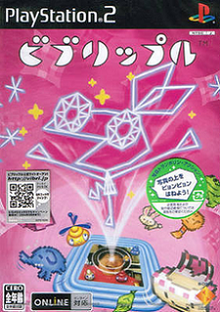| Vib-Ripple | |
|---|---|
 | |
| Developer(s) | NanaOn-Sha[a] |
| Publisher(s) | Sony Computer Entertainment |
| Designer(s) | Masaya Matsuura |
| Platform(s) | PlayStation 2 |
| Release |
|
| Genre(s) | Action |
| Mode(s) | Single-player |
Vib-Ripple[b] is a 2004 video game developed by NanaOn-Sha and published by Sony Computer Entertainment for the PlayStation 2. It was designed by Masaya Matsuura, who also led the development the 1999 PlayStation game Vib-Ribbon,[2] to which Vib-Ripple is a sequel. It was released exclusively in Japan.
The game was first mentioned in a catalog list of presentation at the 2002 Game Developers' Conference with a talk by Masaya Matsuura titled "The Game Design of Vib Ribbon 2".[3]
Vib-Ripple is notable for allowing the player to import photographs to be used as the game's playing field.
Gameplay
[edit]The player takes control of Vibri, a simple, vector-shaped rabbit from the game's predecessor Vib-Ribbon. The game puts the player on top of various photographs, using each one as a trampoline. Jumping on a photograph loosens up 2D items called "Peta Characters", which Vibri must collect before a time limit expires. An icon on the left side of the screen gives the player a hint as to what part of the photograph to jump on to find the item; the icon's color, shape, and size corresponds to a certain combination of the three on the photograph.[4] When Vibri is close enough to the item, a drumming sound is made and the controller vibrates. Vibri must also avoid creatures called "Boonchies" that inhabit the surface of the picture. Coming in contact with a Boonchie will cause Vibri to de-evolve from a rabbit, to a frog, to a worm, and eventually cause a Game over. However, it is possible for Vibri to evolve into a form called "Super Vibri", allowing the player to temporarily disable a Boonchie, as well as see hidden Peta Characters.[4]
Vib-Ripple has 60 default photographs. The player can create their own stages by uploading their own photographs from a digital camera or cellphone via the PlayStation 2's USB port, or even send pictures across the system's online network. The game automatically scales photographs down to 256 by 256 pixels.[5]
See also
[edit]Notes
[edit]References
[edit]- ^ "JAPANスタジオ作品一覧 2005年~2003年" [List of Japan Studio works 2005–2003] (in Japanese). Sony Interactive Entertainment. 2021. Archived from the original on February 25, 2021. Retrieved March 1, 2021.
- ^ Fox, Matt (2013). The video games guide: 1,000+ arcade, console and computer games, 1962-2012 (2nd ed.). Jefferson, N.C: McFarland & Company, Inc., Publishers. p. 315. ISBN 978-0-7864-7257-4.
- ^ "Gaming Intelligence Agency - Vib Ribbon 2 confirmed for development". archive.thegia.com. January 17, 2002. Retrieved July 12, 2024.
- ^ a b Gantayat, Anoop (May 28, 2004). "Vib Ripple Playtest". IGN.com. Retrieved November 9, 2008.
- ^ Vib-Ripple Manual. Japan: Sony Computer Entertainment. 2004. p. 32.